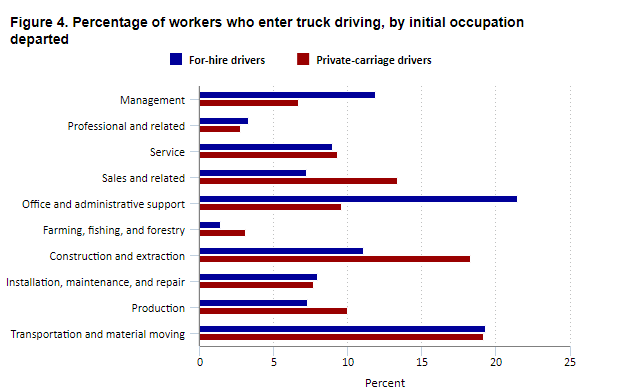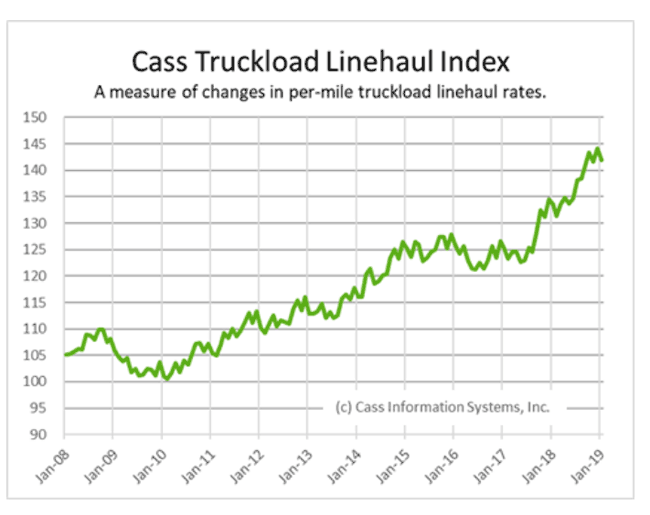We all know there is a severe shortage of US truck drivers, which is only going to get worse over time, right?
SCDigest regularly reports on this topic, noting the often near 100% turnover rate at truckload carriers, according to quarterly ATA data, carriers regularly lamenting the lack of drivers in quarterly earnings calls, frequent pay raises in recent years (at last), etc.
Supply Chain Digest Says... |
|
| Carriers don't believe they can raise driver wages sufficiently to alleviate the driver tshortage because they think they won't get paid for it by shippers. |
 |
What do you say? |
| Click here to send us your comments |
 |
| Click here to see reader feedback |
|
|
The cause? In part, it is widely believed, a lack of interest in younger workers in driving a truck, driven in part by a tough lifestyle on the road.
There is some truth in all that - but maybe not quite as much as most in the industry probably believe. That is clearly the conclusion of a new report from the US Labor Dept. that analyzes market for truck drivers.
The report is written by economists and reads that way, but we wrestled with enough of the data to make some sense.
Why study the market for drivers? As the report notes early on, "The trade press covering the US trucking industry often portrays the US labor market for truck drivers as dysfunctional, citing persistent driver shortages and high levels of firm-level turnover and predicting significant resulting constraints on the supply of motor freight services."
Given the huge role of trucking in keeping goods and the economy flowing, taking a deeper dive makes a lot of sense, the report notes.
In addition, the report cites the believe among many in the industry that the market for truck drivers is somehow structurally broken, and thus does not behave the way a normal labor market would.
After looking at the data, the Labor Dept. disagrees, noting that in general "it is unusual for a market to be consistently out of equilibrium in the direction of a shortage over more than a decade," which many in the industry claim is the case for drivers, with the shortage really started taking off in about 2005 and persisted ever since.
As a baseline, the report says were approximately 1.75 million heavy and tractor-trailer truck drivers in the United States in 2017, along with 877,670 light truck or delivery services drivers and 427,000 driver/sales workers.
One interesting and not often made point is that drivers who are engaged in any aspect of interstate transportation are not subject to the Fair Labor Standards Act's overtime provisions, which govern the majority of other private and public sector occupations. That lack of overtime pay has a big impact, as the report says most tractor-trailer drivers work far in excess of 40 hours per week.
Demand for drivers has been strong since 2003, which does indicate a tight labor market. That while jobs in most other "blue collar" occupations such as manufacturing in the US have declined over the same period.
Heavy duty truckers on average made about $44,000 per year in 2016. That was a couple of thousands of dollars per year more than for all blue collar workers, which in turn earned a couple of thousand more per year than all truck drivers, including local delivery drivers and long haul.
Given all the reporting about driver turnover, perhaps the most surprising data in the report are those showing the percent of drivers that stay in the job from one year to the next.
(See More Below)
|
CATEGORY SPONSOR: SOFTEON |
|
|
| |
|
|
Over the entire timespan from 2004 to 2017, roughly 82% of those who were for-hire drivers in period 1 remained for-hire drivers in period 2. The corresponding figure for private-carriage drivers is 71% Across all drivers in the sample, the 1-year occupational migration rate is 22%, and those rates have not changed meaningfully in recent years.
Comparing drivers leaving the occupation to that in other jobs, the report finds that "the pattern for all drivers is similar to that for workers in the overall economy" - not far in excess as many seem to believe.
Also interesting are what jobs drivers left to enter trucking. As seen in the graphic below, while construction is a large source of for-hire carrier jobs, that is actually eclipsed by "management" jobs of one kind or another (13%), transportation and material moving" (19%) and the top source general office work (22%).

Manufacturing was the source of just 8% of new for-hire drivers.
And there is no question that expected pay and actual pay play a key role, not surprisingly, in workers coming into or leaving driving jobs, the report finds.
The report does note that within driving jobs overall there is a secondary market for long-distance truckload positions, where the shortage may of course be more acute.
But then the report makes this interesting comment: "The long-distance TL segment has high levels of competition, similar average costs across all scales of production, and a very limited ability to differentiate prices in the product market. These characteristics result in labor market conditions in which individual firms are forced to accept high turnover as a cost-minimizing response to their competitive position in the market for their outputs."
In other words, carriers don't believe they can raise driver wages sufficiently to alleviate the driver shortage because they think they won't get paid for it by shippers.
It then adds that "Economists would not regard high turnover rates and the associated problems of recruiting and retaining drivers in this part of trucking as a long-term shortage. Nor would they call these conditions a "broken market," except to the extent that one might use that term for a secondary labor market segment, since the high turnover that marks such a segment is an indicator that the jobs in it are unattractive to many potential employees."
It then notes that "Drivers with higher earnings and hours in period 1 are less likely to leave driving in period 2. "
Meaning that all it would take to solve the driver shortage is truly higher pay – but those that take the leap are likely to be undercut by carriers with lagging pay – even if they do suffer more turnover.
The full report can be found here: Is the U.S. labor market for truck drivers broken?
Any reaction to the data in this interesing report? Let us know your thoughts at the Feedback section below.
Your Comments/Feedback
|

